INSTITUT SUPERIEUR D'ANTHROPOLOGIE
INSTITUTE OF ANTHROPOLOGY
ONLINE COURSES / COURS A DISTANCE
FALL TERM : OCTOBER 2017
REGISTER NOW
ARGENTINE –  San Martin de Los Andes - The genetic analysis of ceramics, excavated by archaeologist Dr Alberto Perez, shows that they contain traces of the cold-resistant yeast strain Saccharoymyces eubayanus, one of the ‘parents’ of the hybrid strain Saccharomyces pastorianus used in the production of lager. Dr Perez uncovered the pottery fragments near San Martin de Los Andes in Argentina, close to the Chilean border, last year. Dr Perez who is based at Universidad Catolica de Temuco in Chile, said: “This is the first archaeological evidence and earliest evidence of any kind of Saccharomyces eubayanus being used in alcohol production. Our findings confirm the historical presence of the yeast in this region and now we have confirmation of its use.” “Saccharomyces eubayanus turned up in remains from two of the sites [out of 6 excavated]. We had strong evidence showing the ceramics had been used to ferment vegetal products to produce alcoholic beverages”. In 2011, Dr Chris Hittinger from the University of Wisconsin-Madison along with a team of geneticists and microbiologists from the US, Portugal and Argentina discovered S. eubayanus in wild samples from a Nothofagus tree in Patagonian forests. Although S. eubayanus’ presence in South America is known, this find is the first and earliest archaeological evidence of it being used to produce alcohol. Despite being native to America, it was believed that its use in the production of alcohol did not occur until the 15th century, with lager thought to have originated in Bavaria in the 1400s.
San Martin de Los Andes - The genetic analysis of ceramics, excavated by archaeologist Dr Alberto Perez, shows that they contain traces of the cold-resistant yeast strain Saccharoymyces eubayanus, one of the ‘parents’ of the hybrid strain Saccharomyces pastorianus used in the production of lager. Dr Perez uncovered the pottery fragments near San Martin de Los Andes in Argentina, close to the Chilean border, last year. Dr Perez who is based at Universidad Catolica de Temuco in Chile, said: “This is the first archaeological evidence and earliest evidence of any kind of Saccharomyces eubayanus being used in alcohol production. Our findings confirm the historical presence of the yeast in this region and now we have confirmation of its use.” “Saccharomyces eubayanus turned up in remains from two of the sites [out of 6 excavated]. We had strong evidence showing the ceramics had been used to ferment vegetal products to produce alcoholic beverages”. In 2011, Dr Chris Hittinger from the University of Wisconsin-Madison along with a team of geneticists and microbiologists from the US, Portugal and Argentina discovered S. eubayanus in wild samples from a Nothofagus tree in Patagonian forests. Although S. eubayanus’ presence in South America is known, this find is the first and earliest archaeological evidence of it being used to produce alcohol. Despite being native to America, it was believed that its use in the production of alcohol did not occur until the 15th century, with lager thought to have originated in Bavaria in the 1400s.
https://www.thedrinksbusiness.com/2017/09/archaeological-find-suggests-lager-may-originate-in-south-america/
GRECE – 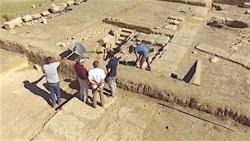 Eubée - Archaeologists have discovered an ancient temple of Artemis at the foot of Paleoekklisies hill, near the fishing town of Amarynthos, on the Greek island of Euboea. The site of the temple is about 10km from the place where it was previously thought to be. Archaeologists discovered parts of a massive wall dating back to the classical era, which they believe belongs to the stoa or portico built near the temple. Exploratory trenches were opened in Amarynthos in 2012, and the Swiss team unearthed a larger part of the building. Artifacts that were found with inscriptions indicate that this is the site of Artemis Amarynthia; which was the end point of the annual procession of people from the once prosperous trading city of Eretrea; 10km away. The ancient civilization held a festival in honor of Artemis; who was the goddess of hunting in Greek mythology. She was worshiped as the patron goddess of Amarynthos; which takes its name from an Eretrean man who was besotted with Artemis.
Eubée - Archaeologists have discovered an ancient temple of Artemis at the foot of Paleoekklisies hill, near the fishing town of Amarynthos, on the Greek island of Euboea. The site of the temple is about 10km from the place where it was previously thought to be. Archaeologists discovered parts of a massive wall dating back to the classical era, which they believe belongs to the stoa or portico built near the temple. Exploratory trenches were opened in Amarynthos in 2012, and the Swiss team unearthed a larger part of the building. Artifacts that were found with inscriptions indicate that this is the site of Artemis Amarynthia; which was the end point of the annual procession of people from the once prosperous trading city of Eretrea; 10km away. The ancient civilization held a festival in honor of Artemis; who was the goddess of hunting in Greek mythology. She was worshiped as the patron goddess of Amarynthos; which takes its name from an Eretrean man who was besotted with Artemis.
VIDEO = http://greece.greekreporter.com/2017/09/20/swiss-archaelogists-discover-ancient-temple-of-artemis-on-euboea/
TURQUIE – 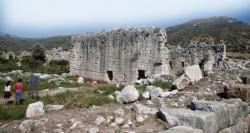
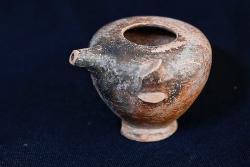 Patara - More than 200 utensils that are 2,350 years old, including a bronze mirror frame and a fork, have been unearthed in the ancient city of Patara, located in the Kaş district of Antalya province. The excavation works in Patara started in 1988 and are being continued by the head of Akdeniz University's Archaeology Department Prof. Havva Işık and her team. Implying that Patara was the prophecy center of Apollo, the god of art, music, sun, poem and fire in mythological sources, Işık said Saint Nicholas, who is an important figure in the Christian world, was also born there, and he created his teachings in Myra. She added that they have focused on the area around the Nero Hamam this year, and the excavation works in the basilica and Tepecik Acropolis in the heart of the city are ongoing. "Tepecik Acropolis, which is the most important area of the excavations, houses the earliest settlement. This is why the most important findings have been found there," Işık said. She indicated that they are trying to reveal the Hellenistic and classical period with the findings there. Noting that they discovered many interesting artifacts in the excavations of the Tepecik acropolis, Işık said more than 200 works have been found in a construction site that was demolished because of an earthquake or fire. The goods, which have been found together in the same area including meal bowls, weights, sculptures and coins, are in good shape. Noting that the earthenware baby bottle, bronze mirror frame and iron fork were important findings, vice head of the Patara excavations associate professor Şevket Aktaş said, "We think these findings belong to an important figure. We have found more than 200 household goods together. They date back to 2,350 years ago. We date them at the end of the Hellenistic period and the beginning of the Classical period. We generally discover broken pieces in excavations. However, it was so exciting that we have found them simultaneously and in preserved shape."
Patara - More than 200 utensils that are 2,350 years old, including a bronze mirror frame and a fork, have been unearthed in the ancient city of Patara, located in the Kaş district of Antalya province. The excavation works in Patara started in 1988 and are being continued by the head of Akdeniz University's Archaeology Department Prof. Havva Işık and her team. Implying that Patara was the prophecy center of Apollo, the god of art, music, sun, poem and fire in mythological sources, Işık said Saint Nicholas, who is an important figure in the Christian world, was also born there, and he created his teachings in Myra. She added that they have focused on the area around the Nero Hamam this year, and the excavation works in the basilica and Tepecik Acropolis in the heart of the city are ongoing. "Tepecik Acropolis, which is the most important area of the excavations, houses the earliest settlement. This is why the most important findings have been found there," Işık said. She indicated that they are trying to reveal the Hellenistic and classical period with the findings there. Noting that they discovered many interesting artifacts in the excavations of the Tepecik acropolis, Işık said more than 200 works have been found in a construction site that was demolished because of an earthquake or fire. The goods, which have been found together in the same area including meal bowls, weights, sculptures and coins, are in good shape. Noting that the earthenware baby bottle, bronze mirror frame and iron fork were important findings, vice head of the Patara excavations associate professor Şevket Aktaş said, "We think these findings belong to an important figure. We have found more than 200 household goods together. They date back to 2,350 years ago. We date them at the end of the Hellenistic period and the beginning of the Classical period. We generally discover broken pieces in excavations. However, it was so exciting that we have found them simultaneously and in preserved shape."
https://www.dailysabah.com/history/2017/09/20/2350-year-old-goods-unearthed-in-patara-reveal-ancient-way-of-life
TURQUIE – 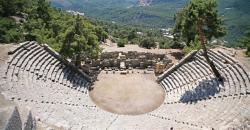 Arykanda - Excavations in the ancient city of Arykanda in the southern province of Antalya’s Finike district, have unearthed the ruins of a 1,700 year-old villa. The findings in the ancient city show the importance of the city in the ancient times, said the archaeologists. The head of excavations Associate Professor Macit Tekinalp said Arykanda was built on terraces because of its topographic features.He said public buildings were also built on terraces and Arykanda bears the name of a big rock in its skirt, meaning “the places next to high rock.” He said Arykanda was mentioned in some resources as the place where “lotus-eaters” lived. “There are six baths in this ancient city. The expression ‘lotus-eaters’ may have been used because of these baths. This city is on the skirt of a mountain, which is hard to reach. We do not have too much evidence that life was luxurious here,” he added. Tekinalp said Arykanda was not on the route of Alexander the Great and did not see many wars, adding the city used all the advantages of being on a main road. Tekinalp said a villa structure from 435 A.D. was unearthed during excavations and the villa is thought to have been destroyed by a fire but it gives important clues about its period.“We think the villa collapsed during a fire in 435 A.D. It gives us important archaeological data. The ancient cities that went through fire or earthquake are very important to us. Because we can reach the tools people were not able to take. We also found the name of the person who owned this villa on a mosaic in the ground. His name is Pierus, who we think had a big family. The structure has eight big rooms,” he said. Tekinalp also said the villa had a view overlooking the city and one of the prestigious residences at the time. “There is a special bath used by Pierus and his family. They also used the bath commercially by renting it. The villa turned to two-room houses in the following years. There is also a pool in the courtyard of the villa and it has a view. These findings shed light on the life of an aristocrat in the fourth century,” he said. According to Tekinalp, the second floor of the villa was made of wood and mosaics were processed on it and they had seen it for the first time during the excavation. Tekinalp said they found the ruins of three more villas in the ancient city and that their owners were privileged people in the late Roman era. He depicted the ancient city of Arykanda as established on a valley in a forest whose most important income was forest products and trade. Although it is a mid-size settlement, there were six baths, Tekinalp said.“Baths were the centers of attraction in a city. People on the coastline came to this city to cool off. This region served as a tableland. We think it was popular in local tourism. Otherwise, we cannot explain the existence of six baths. The population is not enough for six baths. The city is the most important connection road between the coast and Anatolian plateau in the central Lycian region. People on this route accommodated there,” he said.Tekinalp also said there were intense relations between Egypt and Lycia in the Hellenistic era and they had also unearthed findings related to the Egyptian faith.
Arykanda - Excavations in the ancient city of Arykanda in the southern province of Antalya’s Finike district, have unearthed the ruins of a 1,700 year-old villa. The findings in the ancient city show the importance of the city in the ancient times, said the archaeologists. The head of excavations Associate Professor Macit Tekinalp said Arykanda was built on terraces because of its topographic features.He said public buildings were also built on terraces and Arykanda bears the name of a big rock in its skirt, meaning “the places next to high rock.” He said Arykanda was mentioned in some resources as the place where “lotus-eaters” lived. “There are six baths in this ancient city. The expression ‘lotus-eaters’ may have been used because of these baths. This city is on the skirt of a mountain, which is hard to reach. We do not have too much evidence that life was luxurious here,” he added. Tekinalp said Arykanda was not on the route of Alexander the Great and did not see many wars, adding the city used all the advantages of being on a main road. Tekinalp said a villa structure from 435 A.D. was unearthed during excavations and the villa is thought to have been destroyed by a fire but it gives important clues about its period.“We think the villa collapsed during a fire in 435 A.D. It gives us important archaeological data. The ancient cities that went through fire or earthquake are very important to us. Because we can reach the tools people were not able to take. We also found the name of the person who owned this villa on a mosaic in the ground. His name is Pierus, who we think had a big family. The structure has eight big rooms,” he said. Tekinalp also said the villa had a view overlooking the city and one of the prestigious residences at the time. “There is a special bath used by Pierus and his family. They also used the bath commercially by renting it. The villa turned to two-room houses in the following years. There is also a pool in the courtyard of the villa and it has a view. These findings shed light on the life of an aristocrat in the fourth century,” he said. According to Tekinalp, the second floor of the villa was made of wood and mosaics were processed on it and they had seen it for the first time during the excavation. Tekinalp said they found the ruins of three more villas in the ancient city and that their owners were privileged people in the late Roman era. He depicted the ancient city of Arykanda as established on a valley in a forest whose most important income was forest products and trade. Although it is a mid-size settlement, there were six baths, Tekinalp said.“Baths were the centers of attraction in a city. People on the coastline came to this city to cool off. This region served as a tableland. We think it was popular in local tourism. Otherwise, we cannot explain the existence of six baths. The population is not enough for six baths. The city is the most important connection road between the coast and Anatolian plateau in the central Lycian region. People on this route accommodated there,” he said.Tekinalp also said there were intense relations between Egypt and Lycia in the Hellenistic era and they had also unearthed findings related to the Egyptian faith.
http://www.hurriyetdailynews.com/ruins-of-ancient-villa-found-in-antalya.aspx?pageID=238&nid=118136&NewsCatID=375
FRANCE – 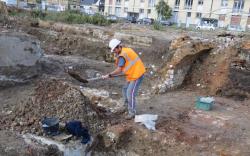 Beauvais - La rue Robert, à Beauvais, a été remise en lumière ces dernières semaines grâce aux fouilles archéologiques de l’ancien théâtre de la ville. Cette rue et la dizaine de maisons qui la constituaient représentent la découverte majeure de l’équipe d’archéologues qui travaillent sur ce chantier depuis la mi-août. « Cela nous donne la vision d’un quartier de Beauvais au XVIIe siècle, indique Sébastien Lefèvre, chef du chantier. On a découvert une dizaine de caves datant de cette époque. Elles ont continué à être utilisées par les habitants jusqu’en 1940 et les bombardements qui ont frappé Beauvais. Dans ces caves, nous avons retrouvé un certain nombre d’objets. Il y a également les jardins avec, pour la plupart, une fosse avec les détritus de la vie quotidienne. Cela va nous permettre de connaître l’aisance des habitants de ce quartier de la ville intra-muros. D’autre part, le service régional archéologique a limité nos fouilles à 2 m de profondeur, ce qui correspond à la taille des fondations du futur théâtre. Même si nous avons trouvé les vestiges d’une rue romaine, nous savions que les vestiges gallo-romains sont plus profonds. »
Beauvais - La rue Robert, à Beauvais, a été remise en lumière ces dernières semaines grâce aux fouilles archéologiques de l’ancien théâtre de la ville. Cette rue et la dizaine de maisons qui la constituaient représentent la découverte majeure de l’équipe d’archéologues qui travaillent sur ce chantier depuis la mi-août. « Cela nous donne la vision d’un quartier de Beauvais au XVIIe siècle, indique Sébastien Lefèvre, chef du chantier. On a découvert une dizaine de caves datant de cette époque. Elles ont continué à être utilisées par les habitants jusqu’en 1940 et les bombardements qui ont frappé Beauvais. Dans ces caves, nous avons retrouvé un certain nombre d’objets. Il y a également les jardins avec, pour la plupart, une fosse avec les détritus de la vie quotidienne. Cela va nous permettre de connaître l’aisance des habitants de ce quartier de la ville intra-muros. D’autre part, le service régional archéologique a limité nos fouilles à 2 m de profondeur, ce qui correspond à la taille des fondations du futur théâtre. Même si nous avons trouvé les vestiges d’une rue romaine, nous savions que les vestiges gallo-romains sont plus profonds. »
http://www.leparisien.fr/beauvais-60000/les-fouilles-archeologiques-du-theatre-exhument-une-rue-du-beauvais-du-xviie-15-09-2017-7264008.php
FRANCE –  Angers - Alors que les travaux de terrassement s’achèvent près de l’ancienne fontaine en bas de la montée Saint-Maurice, un trou de cinq mètres de profondeur reste béant. Au bord, Martin Pithon, archéologue à l’Inrap (Institut national de recherches archéologiques préventives) pointe du doigt une couche de terre grisâtre.« Ce sont des sédiments de l’ancien lit de la Maine qui a été comblé, semble-t-il, vers le XVe siècle. On y a trouvé plein de choses. » Le secret d’une telle découverte dans une matière organique tient en deux éléments : le niveau de vase humide et le peu d’oxygénation, propice à la conservation.« À l’époque, la rivière servait d’égout à ciel ouvert. » Entre autres déchets vieux de plusieurs siècles, des tessons de poterie, du cuir, une écuelle en bois, des lacets, des os d’animaux consommés, ou des clous en métal.« Quand les archéologues font les poubelles, ça fait leur bonheur ! » Toutes ces pièces sont destinées à être restaurées dans un laboratoire nantais. « Le cuir, par exemple, va être stabilisé pour ne pas pourrir. » Analysé, il donnera des éléments de cordonnerie ou de bourrellerie. D’après son épaisseur, sa nature, son travail, on en connaîtra plus sur la vie quotidienne de ces gens de peu du Moyen-Âge. Plus encore, les recherches archéologiques prescrites par le service régional ont mis au jour des restes de la ville basse, tournée vers la rivière depuis le Moyen-Âge.
Angers - Alors que les travaux de terrassement s’achèvent près de l’ancienne fontaine en bas de la montée Saint-Maurice, un trou de cinq mètres de profondeur reste béant. Au bord, Martin Pithon, archéologue à l’Inrap (Institut national de recherches archéologiques préventives) pointe du doigt une couche de terre grisâtre.« Ce sont des sédiments de l’ancien lit de la Maine qui a été comblé, semble-t-il, vers le XVe siècle. On y a trouvé plein de choses. » Le secret d’une telle découverte dans une matière organique tient en deux éléments : le niveau de vase humide et le peu d’oxygénation, propice à la conservation.« À l’époque, la rivière servait d’égout à ciel ouvert. » Entre autres déchets vieux de plusieurs siècles, des tessons de poterie, du cuir, une écuelle en bois, des lacets, des os d’animaux consommés, ou des clous en métal.« Quand les archéologues font les poubelles, ça fait leur bonheur ! » Toutes ces pièces sont destinées à être restaurées dans un laboratoire nantais. « Le cuir, par exemple, va être stabilisé pour ne pas pourrir. » Analysé, il donnera des éléments de cordonnerie ou de bourrellerie. D’après son épaisseur, sa nature, son travail, on en connaîtra plus sur la vie quotidienne de ces gens de peu du Moyen-Âge. Plus encore, les recherches archéologiques prescrites par le service régional ont mis au jour des restes de la ville basse, tournée vers la rivière depuis le Moyen-Âge.
https://www.ouest-france.fr/pays-de-la-loire/angers-49000/angers-avait-ici-un-petit-quartier-maintenant-oublie-5239501